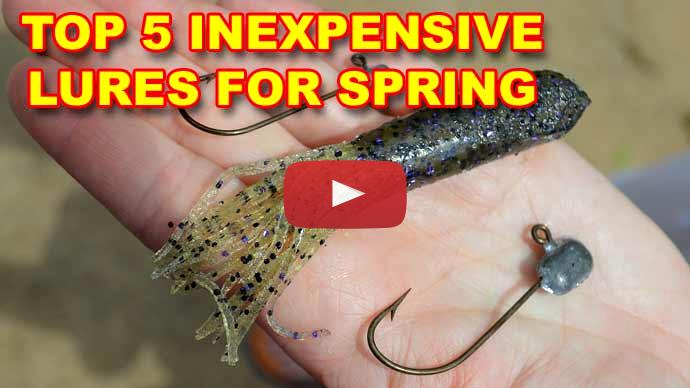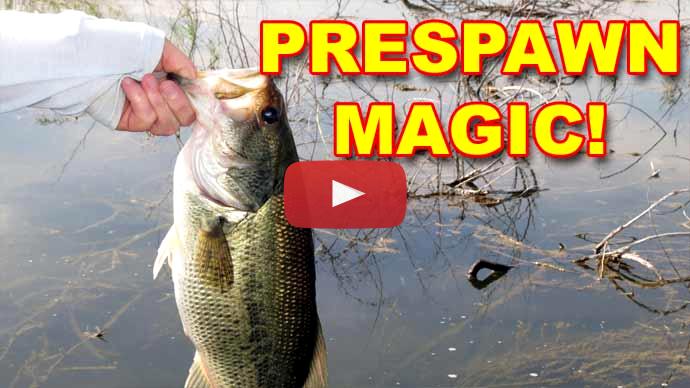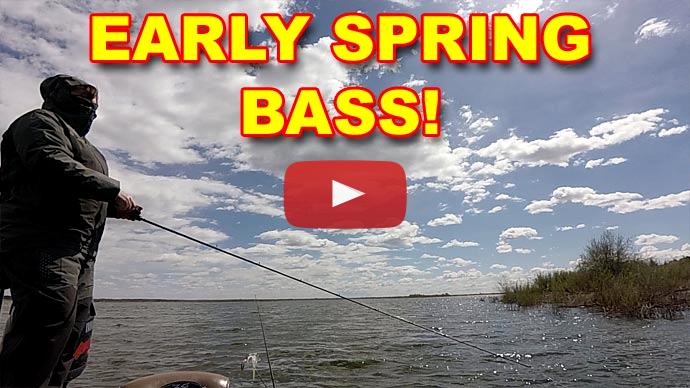Let's talk about five baits for early spring bass fishing, starting with the jig. The jig, of course, works year-round. The jig is a mainstay. It's very popular because it works really well. It's a great bait to fish. So why am I particularly singling it out for early spring? Well, that's because that's when the crawfish start to get active as the water warms up. Now, no, crawfish, no, they don't hibernate during the winter, but they don't really move around much at all during the wintertime. But when that water starts to warm up, then they get active and start moving around. And man, they're just full of protein, man. It's a protein snack, and the bass are seeking them out. They start foraging on them as soon as the crawfish get active. And that could be up in the early 40s, the low 50s, though, that temperature range. Right in there, that's when you'll start catching a lot of bass on, matter of fact, some of the largest bass I've caught are in early, early spring, when the water temp's 46, 47 degrees, and catch them on a jig.
What jigs to use? I use a 3/8th ounce or a half-ounce jig, typically a brown or a green-colored jig is what I like to use with a Rage Craw trailer on it. You know, that's my mainstay. And the trailer color is gonna match the skirt color for me, and it does exceedingly well for me. I tend to fish it on long tapering points. I fish it in sharper drops, sharper banks, steep banks, ledges, not up in the flats too much. I don't get too shallow. I may fish it a little bit, up to five feet, four feet deep, but I'm still not in that two foot, three foot range yet, because the water temperature is still pretty cool. The best success I've had in catching bigger fish is on those drops immediately adjacent to shallower water, like in that 6 to 8-foot range, 6 to 10-foot range. It bottoms out right there. It's like a big steep drop, and here's the bottom. Right on that edge, that crease, that's where those bass like to set. You get that jig right down there and just crawl it along that edge or hop it right along there.
If you can find a transition area where it goes from a hard bottom to soft bottom or rocky bottom to sand, or maybe there's some trees and bushes and some weeds and then there's nothing, right along those, those are like hotspots. Those are places to fish that jig. I like to throw it with a 7'4" medium-heavy fast action rod with 12 to 15-pound fluorocarbon line. I like to use Seaguar InvizX line for this, mainly because in this time of year, the water's pretty clear. And typically there's not a lot of weeds and cover to get hung up in, so I don't necessarily need braid. So going with the fluorocarbon works best for me. If I am throwing it in heavier cover though, I will up it to a braid, especially if it's a vegetation type cover where the bass can get wrapped up around in there, then you want some braid and maybe a little bit heavier rod. But typically that's what I'm fishing with during that time of year with a jig.
The next bait is a suspending jerk bait. Now this, a lot of guys that have been fishing for bass for a long period of time will tell you early spring is prime time for suspending jerk baits. And for good reason. The bass just love them. They crave it. I don't know why, but man, it can be a way of catching a ton of fish in a hurry. I like to use the SPRO McStick 110+1 or the SPRO McRip 85. The +1 gets down to about 12 feet and the 85 gets down to about 10 feet, 8 to 10 feet. Just depends on where the fish are holding that day and targeting those similar areas, those long tapering points, those drop offs, those steep banks, those areas where the fish are going to hold up and stage up and getting ready to go up into the, to spawn. Those are the best places to fish them. And with the, because they're suspending, you can get that bait right down to where the fish are and then just let it sit there and entice them and just be right in their face and wait for them to obliterate it.
Although typically they don't hit it that hard. Typically they just start to feel it pull on your rod. Like, there it is. The fish is there. It's like they got it. The key is getting that bait to suspend. And the baits, any kind of suspending bait, no matter what brand it is, they will vary how well they suspend in the water depending on the water temperature. So keep that in mind. Put that bait in the water and watch it. If it starts to sink too much or rise too much, change it out. For example, if it's sinking a bit, then change out that front hook with the next size smaller hook. If it's rising, then change it out with the next size larger hook. And usually that will balance it out. If that doesn't, then go to the back hook and do the same thing. And if you have to, then change that middle hook. Slight changes and just a little bit of weight difference in those sizes of hook is all it takes to get it to balance out. But that's the key to get it down there and let it sit.
Now in the early spring, the earlier, when the water temps are still in the 40s, you get it down there and give it a good pop and let it sit. Your pauses are going to be longer, like 30 seconds to a minute. As the water temperature starts to warm up into the low 50s, now your pauses are going to be like six seconds, five seconds, maybe only three seconds. Once you get up to the mid to upper 50s, sometimes it's a pop, pop, pop, pop, right? Pop. You just, there's not a whole lot of pauses in between. So your cadence is going to vary depending on the water temperature.
As for colors, I like to use flashy colors if the sun is out so that it reflects that sun and can be seen from further distances. If it's really clear water, I like to use translucent colors like those greens or those bait fish style colors. And then if the water is stained, then I'll use solid colors that resemble the bait fish that are in that lake. Typically a shad color or maybe a perch color or bluegill pattern. Those work really well. Those solid opaque colors work better in those dingy kind of water situations. But that's what you need to throw for suspending jerk baits.
Another bait you want to be throwing in the springtime is a crankbait. Believe it or not, crankbaits actually work really well even when the water temperature is cooler. It's not just a spring and summer bait or a fall bait. A lot of people only throw them in the fall. In the early spring, they can be very productive. But again, remember I mentioned crawdads are highly targeted and highly favored forage baits for the bass during this time of year. So I opt for crawdad pattern crank baits as well. The green pattern ones I like to throw in clearer water. The clearer the water, the better for those green-colored crawdad patterns. And if the water is dingy or muddy, I'll go for the red craw. Yeah, red in early spring. Really good color.
I like the SPRO Rock Crawlers. Those work exceptionally well. You can get them in different diving depths. In an early spring, like in the 40s, that's when you want to dive down deeper, about 12 feet deep, and just bang it off those rocks and give it long pauses in between. As the water temperature warms up, go for a little bit shallower diving ones. Maybe the MD 55 gets it down to about 8 feet. And again, banging it off those rocks, those stumps, off of objects, targeting those steeper banks, those points, those humps, anything, channel swings that come up close to the bank. Any of that is really good areas to throw those crankbaits.
I like to throw it with a medium-action rod and 12-pound fluorocarbon test. This is where I like to use Seaguar Tatsu line. It works really well. It's thin diameter, so it enables the lure to get all the way down to its deepest diving depth and is really abrasion-resistant. And, of course, fluorocarbon sinks, too, so it doesn't prevent the lure from getting all the way down to where it's supposed to. So that's my setup, and those are the lures I use, those crankbaits I use, in spring.
Now, one of my favorite baits to throw in the spring is the tube bait. Yeah, and that's because it's so versatile. There's so many different ways you can rig it, and that makes it so you can fish it in a variety of situations, a variety of water colors, different weather patterns, whether the bass are really active, and depending on if they're buried up in the bushes or if they're under docks, around the open water. Typically what I do for early spring is I first like to throw tubes on the back of a split-shot rig in deeper water. That's when the water temperature's still in the 40's, and just slowly crawl along the bottom. Maybe a slight lifting up and down of the rod tip by maybe 9:00 to 12:00 position, 9:00 to 11:00 position, and just drag it back down to 6:00. Slowly drag it on the bottom using spinning gear. I'm using a 1/16th-ounce split-shot with 6-pound fluorocarbon line. Generally, this is Tatsu that I'm using, the Seaguar Tatsu, just because it's so limber and so sensitive, it doesn't interfere with the action of the bait. That's what I'll do when it's really cold out or if you've got a good front that's come through and shut the fish down. But that's a great way to go after them.
Now, as the water temperature warms up, I'll put that on a flipping outfit. I put a flipping tube on there. There's a Trokar hook out there that I like to use. I'll put it on a quarter-ounce, a 3/8th-ounce weight, nothing heavier than that. I'll even use braided line now, 40-pound, 50-pound braided line, and now throwing, flipping and pitching it into heavy cover. Again, this is when the temperatures warm up into the low to mid-50s and the bass are getting ready to spawn. They'll use that cover as they move up into the shallows and sometimes bury up in there. You can go after them with a Texas rig too this way and dig them out. It's an excellent way to catch a lot of fish with a tube.
There's so many other ways you can fish a tube though. When the water temperature's in the low-50s and you've got a lot of docks, rigging on a conventional tube jig, this is the kind of jig that's got eye towards the back. I shouldn't say the back, but it's not at the front. The eye is offset away from the front of the jig. When you rig it this way, it's open water because you can see the hook will snag on anything, so you can't throw it into heavy cover. But rigged this way, the tube will spiral, this death spiral, and that is just irresistible to bass, pre-spawn bass particularly. I like to throw that around docks. You can skip it up under docks and let it spiral down inside the docks. Oh, my goodness, that's a fun way of catching them. Alongside docks, any kind of open cover, again, boulders, points, rocky structures work really well for this, rocky cover. It's a great technique to use.
I throw this on spinning gear, again, with 6-pound fluorocarbon Tatsu line. You throw it out and basically you kind of just open the reel and let it do its thing and freefall. And you gotta be a line-watcher with this because sometimes the line, all it does is a little jump or it just starts peeling away from you really quickly. Or sometimes when you just reel up that slack suddenly, your line is swimming away from you and the fish has got it. So you have to be real astute, play close attention to that line. It's not easy to do that technique when it's really windy out, so I wouldn't do it during the wind. But pretty much any other time during this time when the water temperature's in the upper-40s to low-50s, it's a great time to throw that bait.
The next lure for early spring fishing is a spinnerbait. Yeah, spinnerbait. I think a lot of guys think about spinnerbaits only in the warmer months, but, man, I fish it year-round, just so you know, just in full disclosure. Now, what I like to throw is two different kind of baits this time of year as far as spinnerbaits goes. One is when the water temperature is super cold. I consider that under below 50. So in the 40s, I'll throw a single Colorado-style blade. White. Half-ounce. And what I like to do with that is throw it again in those steeper drops, steeper points, steeper ledges. Throw it out there and just let it fall vertically. It's a horizontal presentation because it falls still. It's horizontal, but it falls vertically. The blade helicoptering it as it falls. I can't tell you how many fish I catch doing that. Usually it's like 12 to 14 feet deep, a little bit deeper than that. You just throw it and let it fall straight down like you would a plastic or a jig or something like that, but you're using the spinnerbait instead.
It's a different look, a different presentation. A lot of guys don't throw that. I think that's the reason why it gets bit so much, at least for me. But that's a very effective way of catching, and I catch big fish doing that. So that's one way I'll use a spinnerbait. The other is I'll use a three-quarter-ounce spinnerbait, Goldblades, Hank Parker Classic spinnerbait. I've got a ton of them. I love that bait. It just in white with a twin tail trailer, whew, say that fast, as a trailer on it. And again, I'll slow roll that. So get it down towards the bottom and just slowly crank your reel and just bump it along the bottom. I almost won a tournament, over 100 boats in this tournament, doing that in, it was cold. It was really cold. I mean, launch time was about 27, 28 degrees. I was getting ice on the eyelets of my rod. Throwing it up at about 8 to 10 feet of water, right in an area next to a spawning area, The bass were stacked up there, getting ready to move up when the water was right.
The water temperatures were right around 50 degrees. And I was just slowly bringing it along. And you would think the bass would just kind of mouth it and walk off, but no. They clocked it. I mean, they were trying to rip the rod out of my hand. So be prepared for that. Even just because it's a slow presentation doesn't mean the bass aren't going to annihilate it. They will. But that technique works really well. Now, water temperature is right in that, you know, low, upper-50s, low, sorry, low-50s, upper-40s temperature range. Slow rolling it is going to be very, very effective.
As the water temperature warms up, target those outside weed lines. Move up a little bit shallower, maybe along docks. But, again, a moderate retrieve. You're not burning it back really quick. A lot of guys are used to doing spinnerbaits at a fast speed, I think that's why a lot of folks think it's only good in the warmer months. But a slower speed is a necessity during this time of year. And you'd be surprised how many fish you catch on them. I fish it with 15-pound InvizX fluorocarbon line and with a 7-foot medium-heavy fast-action rod. It's like the universal jack-of-all-trades. I've got one rigged and ready all the time year-round. That works universally for me. I can throw it no matter what kind of cover I'm throwing in. And I can catch a lot of fish that way. So those are the five top baits to use during the early spring. I hope you go out there and try them out and you catch a bunch. For more tips and tricks like this, visit Bassresource.com.



